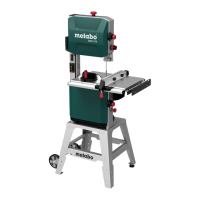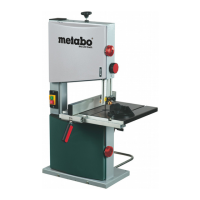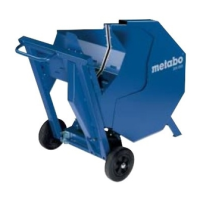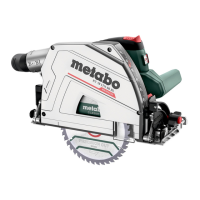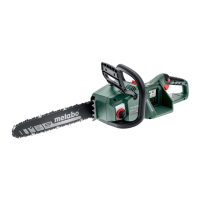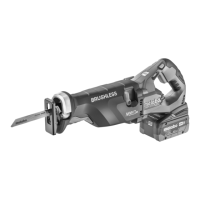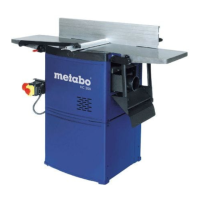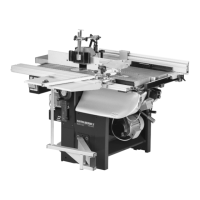ENGLISH en
13
Saw table lateral alignment
Danger!
Risk of injury, even with the saw belt at
standstill. To loosen and tighten the fastening
screws use a tool that allows for keeping your
hand at a sufficient distance from the saw belt.
1. Align saw table (10) such that the saw belt is
located in the middle of the table insert (11).
2. Tighten the four fastening screws (14).
Aligning the saw table at right angles to the
saw belt
1. Position the belt guide (24) at the very top.
(For details see chapter 9.1).
2. Check saw belt tension. (For details see
chapter 8.2).
3. Loosen the clamping screw (13) .
4. Position the saw table (10) horizontally - tilt to
the stop.
5. Tighten again the clamping screw (13) .
6. Use a bracket to check whether the saw table
is perpendicular to the saw belt.
If the saw table is not perpendicular to the saw belt,
please adjust the end stop screw (15) as follows:
1. Loosen the clamping screw (13) .
2. Use a hexagon key to turn the end stop screw
(15) through the hole (9) in the saw table
anticlockwise.
3. Using an angle, align the saw table at a right
angle to the saw belt and tighten again the
clamping screw (13) .
4. Using a hexagon spanner, turn the travel limit
screw (15) through the drilled hole (9) in the
saw table in a clockwise manner, until the
travel limit screw (15) barely touches the saw
housing.
6.5 Installing the Fence Guide
Extrusion
Fasten fence guide extrusion (16) to the saw
table using four wing nuts and washers.
6.6 Fit fence guide extrusion
The rip fence (17) can be fitted both on the left or
the right of the saw belt.
Clamping the rip fence
1. Lock rip fence in the rear table edge.
2. Place the rip fence at the front on the fence
guide extrusion (16).
3. Fasten rip fence by pushing the clamping lever
(18) down.
6.7 Transport
Position upper belt guide (24) at the very bottom.
(For details see chapter 9.1).
Remove projecting accessories.
Do not lift or transport the saw at the safety
installations.
Transport the saw with the help of another person.
Note:
In this chapter the essential operating elements of
the machine are introduced.
The proper use of the machine is described in
chapter "Operation". Read this chapter before
using the saw for the first time.
ON/OFF Switch
Switching on = Press green switch (2).
Switching off = Press red switch (3).
Restart protection: An under-voltage relay is
triggered if the electricity fails. This prevents the
machine from starting up when the power is
restored. To restart, the green switch button must
be pressed.
Housing door turn-lock fastener
Use the turn-lock fastener (5) to open and close
the housing door.
Opening the upper/lower housing door:
1. Rotate the turn-lock fastener (5) several
revolutions in an anti-clockwise manner.
The housing door opens slightly. This
activates the door interlock which switches the
motor off.
Danger from exposed saw belts and
band saw wheels!
If the motor does not switch off immediately
after opening the door or if the door opens
immediately, the door locking mechanism or
the locking system is defective. Shut down the
saw and return it to the Service Centre in your
country for repair.
2. Rotate turn-lock fastener (5) further
anticlockwise.
The housing door opens wide.
Closing the upper/lower housing door:
Press housing door and rotate turn-lock fastener
(5) clockwise until the housing door shuts
cleanly.
Setting knob for band saw belt tension
If necessary, the tension of the saw belt can be
corrected using the setting knob (19). (For details
see chapter 8.2).
Setting knob for angle of the upper band saw
roller (setting the run of the saw belt)
With the setting knob (27) the angle of the upper
band saw roller can be changed if required. By
adjusting the angle, the saw belt is aligned such
that it runs in the middle of the plastic tyres of the
band saw blade rollers. (For details see chapter
10.2).
Saw table tilt
After loosening the clamping screw (13) the saw
table (10) can be tilted infinitely up to 45° against
the saw belt.
Rip fence
The rip fence (17) is clamped to the front and is
also held in place with the hold-down clamp on the
back of the saw table. The rip fence can be used
on both sides of the saw belt. (For details see
chapter 6.6).
Mitre fence
The mitre fence (20) is inserted into the groove in
the saw table from the front.
For mitre cuts the mitre fence turns to 60° in both
directions.
For 45° and 90° mitres positive stops are provided.
To adjust an angle: Release the clamping handle
(21) by turning it anticlockwise.
Risk of injury!
The clamping handle (21) must be tight when
sawing with mitre fence.
Danger!
Start the saw only after the following
preparations have been completed:
– the saw is securely mounted;
–the saw table is installed and aligned;
– the safety devices checked.
Connect the saw to the mains supply only
after all of the above preparations are
completed! Otherwise there is a risk of an
unintentional starting of the saw, which may
cause serious personal injury.
8.1 Connect chip extraction
Danger!
Some types of sawdust (e.g. from oak, beech
and ash) can cause cancer if inhaled: Only
work in a closed room with a dust collector
(air speed at the extraction outlets of the saw
>= 20 m/s).
Caution!
Operation without a dust collector is only
possible:
– outdoors;
– for short use (up to max. 30 minutes);
– with dust respirator.
– If no dust collector is used chips will
accumulate, which need to be removed
periodically.
Connect duct collector or industrial vacuum
cleaner with appropriate adapter to the chip
extraction nozzles (12).
8.2 Tighten saw belt
Danger!
Too much tension can cause the saw belt to
break. Too little tension can cause the driven
band saw wheel to slip and the saw belt to
stop.
1. Move upper belt guide (24) to the very top.
(For details see chapter 9.1).
2. To check the tension, using your finger, press
against the saw belt in the middle between the
saw table and the upper belt guide (you must
not be able to impress the saw belt by more
than 3 to 5 mm laterally)
3. Correct tension if necessary:
– Turning the setting knob (19) clockwise
increases the tension.
– Turning the setting knob (19) anticlockwise
reduces the tension.
8.3 Connection to Power Mains
Danger! High voltage
Operate the saw in only in a dry
environment.
Operate the saw only on a power source
matching the following requirements (see
also "Technical Specifications"):
– Mains voltage and system frequency must
conform to the voltage and frequency
shown on the machine´s rating label;
– Protection with an FI switch with an
residual current of 30 mA;
– outlets properly installed, earthed or
grounded, and tested.
Note:
Check with your local Electricity Board or your
electrician if in doubt whether your house service
connection meets the requirements.
Make sure the power supply cable is out of
the way, so that it does not interfere with
the work and does not pose a tripping
hazard or will get damaged.
Protect the power supply cable from heat,
aggressive liquids and sharp edges.
Use only rubber cables with sufficient
cross-section (3 x 1.5 mm
2
) as extension
cable.
Do not pull on the power supply cable to
unplug.
Danger!
To reduce the risk of personal injury as much
as possible, the following safety
recommendations should be observed when
operating the saw.
Use personal protection gear:
–dust respirator;
– ear protection;
–safety goggles.
Cut only one work piece at a time.
Always hold the work piece down on the
table.
7. Machine Details
8. Initial Operation
9. Operation
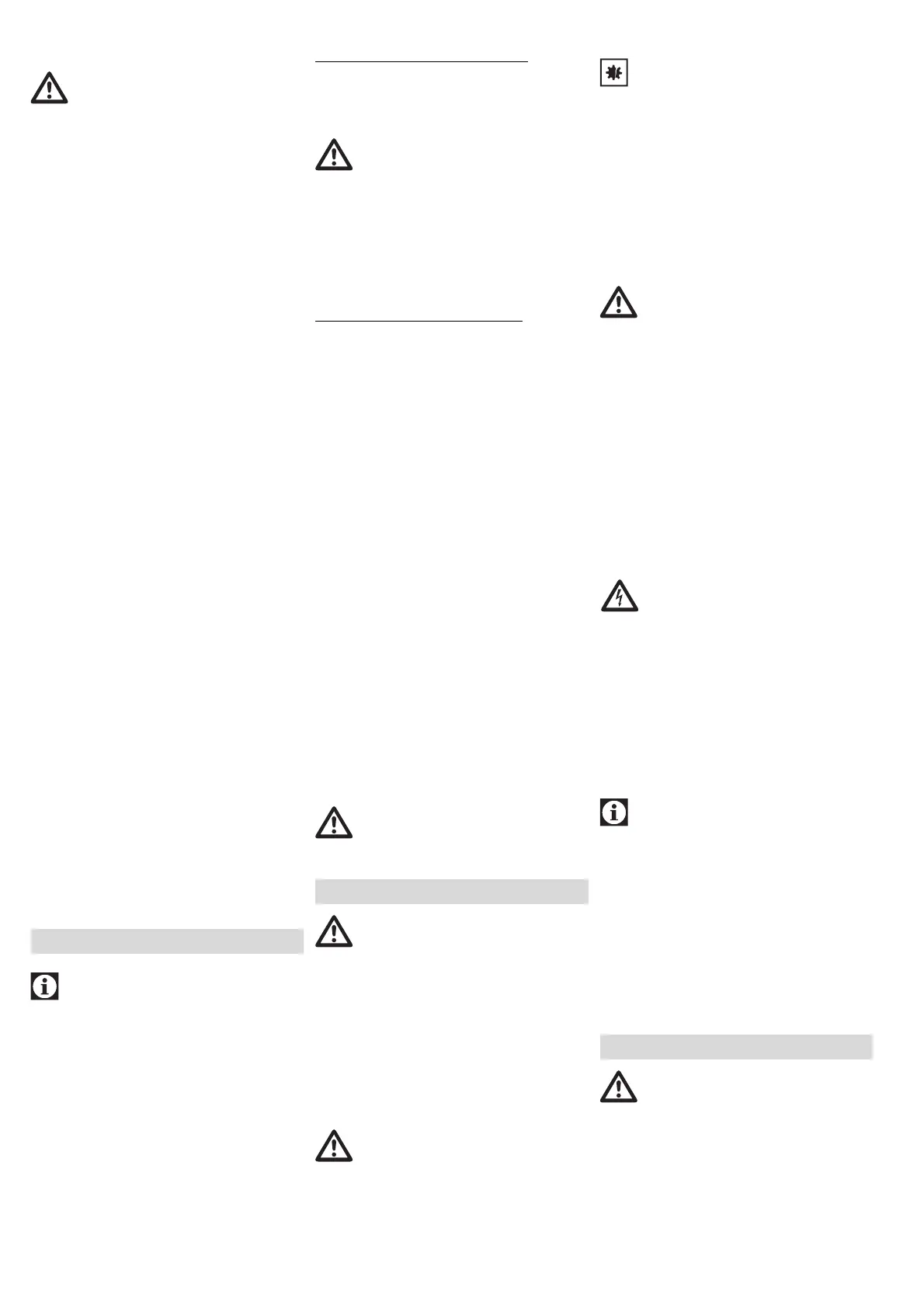